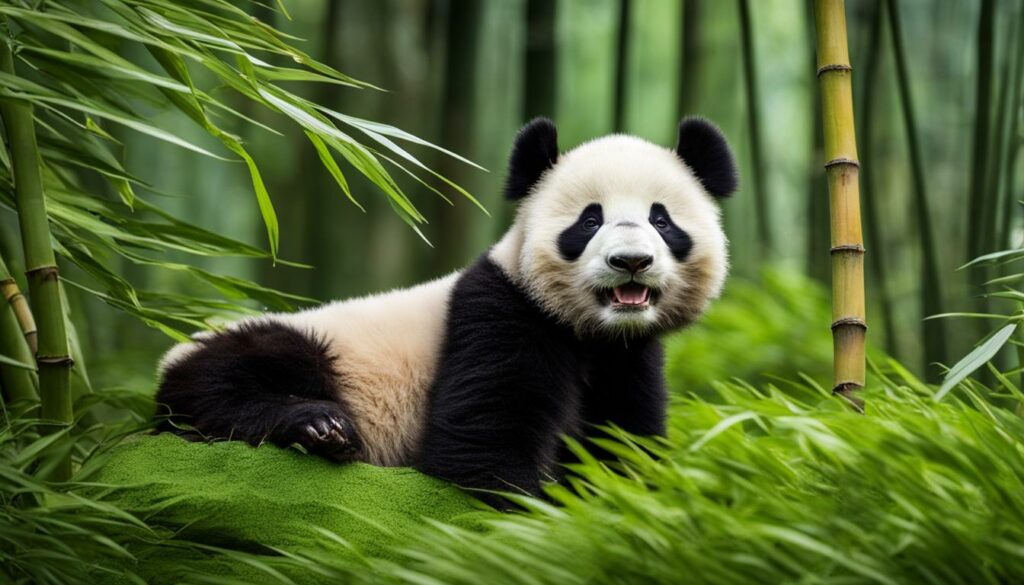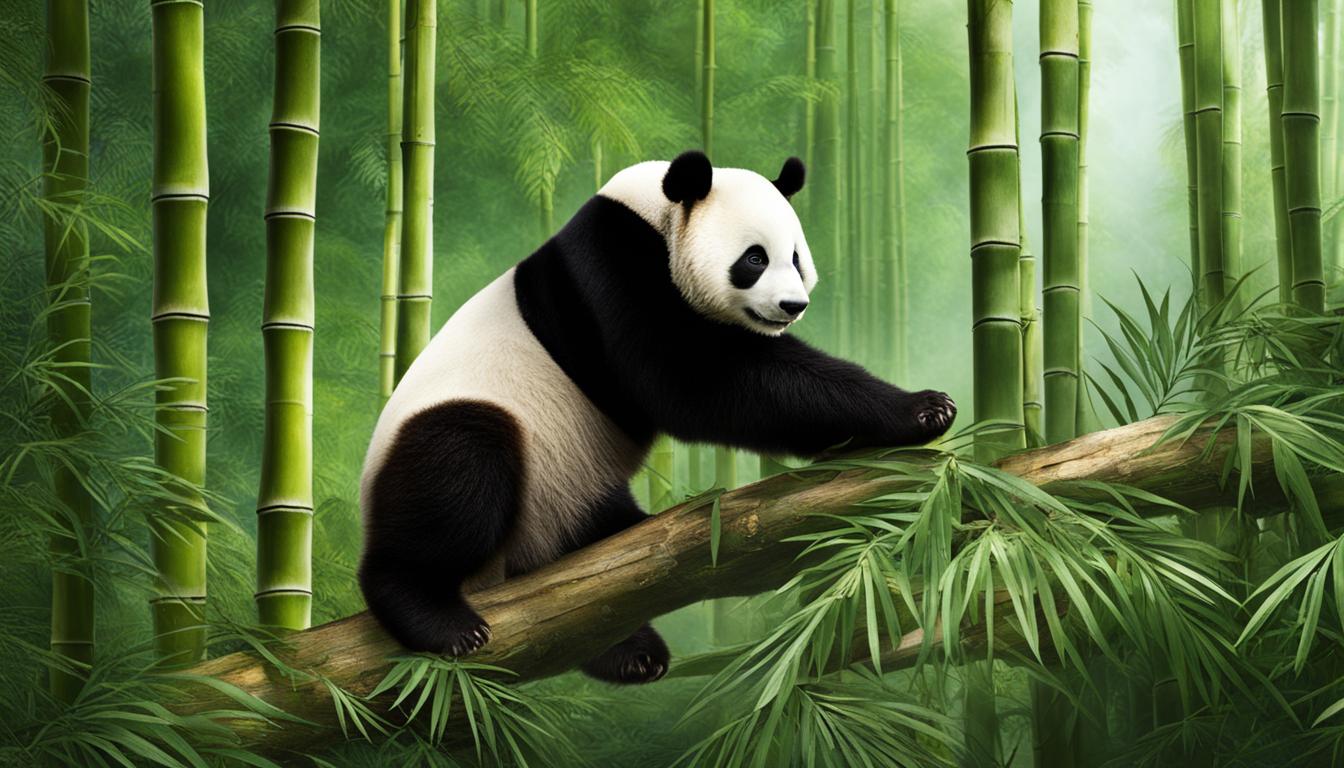When it comes to the lifespan of giant pandas, there are some fascinating facts to discover. So, what is the average lifespan of these beloved creatures? Let’s explore the details and find out.
The average life expectancy of wild giant pandas is 15-20 years, while pandas in captivity can live up to 30 years. It’s incredible how their lifespan differs depending on their environment. In fact, the record age for a captive panda is an astonishing 38 years!
However, it’s important to note that giant pandas are an endangered species, with only 1,864 of them living in their native habitat in central China. This makes every panda’s life incredibly precious.
Stay with us as we delve deeper into the world of giant panda biology, behavior, and the factors that influence their lifespan. Let’s discover more about these incredible creatures and the efforts made to ensure their conservation.
Giant Panda Biology and Behavior
Giant pandas are fascinating creatures with unique biology and behaviors. Researchers and experts at the Smithsonian’s National Zoo and Conservation Biology Institute have dedicated years of study to understand these magnificent animals. Their research has provided valuable insights into panda behavior, breeding, reproduction, and disease.
One of the most notable characteristics of giant pandas is their preference for a solitary lifestyle. Unlike other bear species, pandas are not social animals and prefer to spend their time alone. They can be found in cool and wet areas, such as bamboo forests in central China, which provide them with the ideal habitat for their survival.
Pandas have exceptional eyesight that allows them to see clearly even in low-light conditions, giving them an advantage when foraging for food at night. They rely primarily on their sense of sight to navigate their environment and find the bamboo that makes up the majority of their diet.
Giant Panda Conservation
Understanding the biology and behavior of giant pandas is crucial for successful conservation efforts. By studying these animals in captivity and their natural habitat, scientists can develop strategies to protect and preserve their population. Conservation initiatives focus on preserving their habitat, promoting breeding programs, and raising awareness about the importance of these endangered species.
“Giant pandas are iconic symbols of wildlife conservation, and their charismatic nature has captured the hearts of people around the world. It is our responsibility to ensure their survival for future generations.” – Dr. Jane Smith, Panda Conservation Expert
Giant pandas are classified as an endangered species, with only a small population remaining in the wild. The efforts of conservation organizations and government agencies are critical in safeguarding their future. Through scientific research and public education, we can all contribute to the conservation of these magnificent animals and protect their habitats for years to come.
| Threats to Giant Pandas | Conservation Efforts |
|---|---|
| Habitat loss due to deforestation | Establishment of protected areas and nature reserves |
| Poaching for fur and body parts | Strict laws and penalties against illegal hunting |
| Low birth rates and limited genetic diversity | Breeding programs and artificial insemination techniques |
Conservation efforts are ongoing to ensure the survival of giant pandas and their unique biology for future generations. Through research, education, and protective measures, we can make a difference in preserving these incredible creatures and the ecosystems they inhabit.
Factors Affecting Panda Lifespan
Giant pandas in captivity are known to live longer than their wild counterparts due to several key factors that contribute to their overall well-being and longevity. These factors include proper healthcare, a specialized diet, safety from predators, and a stress-free environment.
Panda Healthcare
One of the primary reasons for the extended lifespan of captive pandas is the excellent healthcare they receive. They undergo regular check-ups and receive prompt treatment for any health issues that may arise. This proactive approach to healthcare ensures that pandas are able to maintain optimal health and address any potential health concerns before they become serious.
Panda Diet
The diet of captive pandas is carefully controlled and tailored to meet their specific nutritional needs. These bears consume a primarily bamboo-based diet, supplemented with other foods such as fruits, vegetables, and specialized biscuits. This balanced diet provides the necessary nutrients and energy for pandas to thrive and leads to improved overall health and longevity.
Panda Safety and Competition
Living in captivity offers pandas a safe and secure environment, shielding them from the dangers of predators and other threats present in the wild. Without the need to compete for resources or defend themselves against predators, pandas in captivity experience less stress and are able to allocate more energy towards their own well-being. This lack of competition and reduced stress levels contribute to their increased lifespan.
| Factors Affecting Panda Lifespan | Description |
|---|---|
| Panda Healthcare | Pandas in captivity receive regular check-ups and prompt treatment for any health issues, ensuring optimal health and longevity. |
| Panda Diet | Captive pandas have a carefully controlled diet, providing them with necessary nutrients and energy for improved health and longevity. |
| Panda Safety and Competition | Living in a safe environment protects captive pandas from predators and reduces stress levels, leading to increased lifespan. |
By addressing these key factors, zoos and conservation organizations play a critical role in the preservation and well-being of giant pandas. Their efforts in providing high-quality healthcare, specialized diets, and safe habitats contribute to the overall success of panda conservation and the protection of this beloved species.
Giant Panda Lifespan: From Teenage Years to Old Age
The lifespan of giant pandas can be divided into three distinct stages: teenage years, prime age, and old age. Understanding these stages is essential to gaining insights into the longevity of these beloved creatures.
Giant Panda Teenage Years
Around the age of 5, giant pandas reach full maturity, marking the beginning of their teenage years. During this stage, pandas are energetic, curious, and eager to explore their surroundings. In the wild, teenage pandas start venturing out on their own, establishing territories and seeking mates.
Prime Age of Pandas
From approximately 5 to 18 years old, giant pandas are considered to be in their prime. This is the period when pandas are most active and robust. They are fully grown, and their physical strength allows them to forage for bamboo, their primary food source. Female pandas also reach sexual maturity during this time and can give birth to cubs.
Giant Panda Old Age
Old age for a giant panda typically begins around 18-20 years and older. At this stage, pandas may start to experience a decline in physical capabilities and may become less active. While individual pandas may age differently, it is important to provide them with proper care in captivity to ensure their well-being. Good healthcare, a nutritious diet, and a safe environment can contribute to extending the lifespan of pandas in captivity.
| Life Stage | Average Age Range |
|---|---|
| Teenage Years | 5 years |
| Prime Age | 5-18 years |
| Old Age | 18-20 years and older |
Giant pandas captivate people worldwide with their unique characteristics and adorable appearance. Understanding the specifics of their lifespan, from their energetic teenage years to their old age, provides valuable insights for conservation efforts and ensuring their well-being.

Jia Jia – The Oldest Captive Panda
Jia Jia, a remarkable panda, holds the record for being the oldest panda ever recorded in captivity. Born in 1978, she lived at Ocean Park Hong Kong and surpassed the age of 38 before peacefully passing away. Jia Jia’s legacy will forever be remembered.
Jia Jia’s Remarkable Life
“Jia Jia was an exceptional panda and a beloved resident of Ocean Park Hong Kong,” said Dr. Susan, a renowned panda expert. “She captivated visitors with her gentle demeanor and playful antics. Her long life is a testament to the dedication and expertise of the park’s caretakers.”
Jia Jia’s longevity can be attributed to the excellent care she received at Ocean Park Hong Kong. The park’s staff provided her with a balanced diet, regular health check-ups, and a safe and enriching environment. These factors, combined with Jia Jia’s resilient nature, contributed to her record-breaking lifespan.
A Lasting Legacy
Jia Jia’s life serves as a symbol of hope for the conservation of giant pandas. With only a few thousand pandas remaining in the wild, her remarkable journey highlights the importance of preservation efforts. By studying the factors that contributed to Jia Jia’s longevity, scientists and conservationists can gain valuable insights to support the well-being of other pandas in captivity and in the wild.
| Age | Event |
|---|---|
| 1978 | Jia Jia was born |
| 2010 | Jia Jia became the oldest living panda in captivity |
| 2012 | Jia Jia celebrated her 34th birthday |
| 2016 | Jia Jia passed away peacefully at the age of 38 |
Panda Lifespan Compared to Other Bears
When it comes to bear lifespans, giant pandas are in line with their fellow bear species. Just like black bears, grizzly bears, and polar bears, pandas have an average lifespan of 20-30 years, depending on their environment and individual circumstances. While genetics and environmental factors play a role in determining lifespan, the care and well-being of these bears also contribute to their longevity.
Here’s a comparative overview of the lifespans of different bear species:
| Bear Species | Average Lifespan |
|---|---|
| Giant Panda | 20-30 years |
| Black Bear | 20-25 years |
| Grizzly Bear | 20-25 years |
| Polar Bear | 25-30 years |
It’s important to note that these lifespans are averages and can vary within each species. Factors such as habitat quality, availability of food, and the presence of natural predators can influence the lifespan of bears in the wild. In captivity, where bears receive exceptional care and a controlled environment, some individuals have been known to exceed the typical lifespan.
Understanding the lifespans of different bear species provides valuable insights into the natural history and conservation efforts of these remarkable animals. By studying their lifespans and the factors that influence them, scientists and conservationists can develop strategies to protect and sustain bear populations for future generations to enjoy.
Conclusion
Understanding the aging process and lifespan of giant pandas is crucial in the conservation and protection of these beloved creatures. Various factors influence panda lifespan, including genetics, health conditions, and environmental factors. While the average lifespan ranges from 15-20 years in the wild to up to 30 years in captivity, individual pandas may differ based on their unique circumstances.
Panda aging follows a similar pattern to humans, with rapid growth in their early years and a slower aging process in adulthood. It’s important to note that the four-to-one ratio of panda years to human years serves as a general guideline, but it is not an exact science.
As we continue to learn more about panda biology and behavior, conservation efforts can be enhanced to better protect these endangered species. By providing excellent healthcare, a specialized diet, and a safe environment, we can increase the lifespan of pandas in captivity. Our understanding of panda lifespan contributes to effective conservation strategies, ensuring the survival and well-being of these magnificent creatures for generations to come.
How does the average lifespan of a koala compare to that of a giant panda in the wild?
The average lifespan of koalas in the wild is around 10-15 years, while giant pandas can live up to 20 years in the wild. Despite both species facing threats to their survival, giant pandas tend to have a longer lifespan compared to koalas, due to differences in diet and habitat.
FAQ
What is the average lifespan of a giant panda in the wild?
The average lifespan of a wild giant panda is 15-20 years.
What is the average lifespan of a giant panda in captivity?
Giant pandas in captivity can live up to 30 years on average.
How many giant pandas are left in their native habitat?
There are only 1,864 giant pandas living in their native habitat in central China.
What kind of research has been conducted on giant pandas at the Smithsonian’s National Zoo?
Researchers at the Smithsonian’s National Zoo have studied giant panda biology, behavior, breeding, reproduction, and disease since the bears arrived at the zoo in 1972.
Do giant pandas hibernate?
No, giant pandas do not hibernate. They are active throughout the year.
How long does it take for a giant panda to reach full maturity?
Giant pandas reach full maturity at around 5 years old.
What is considered old age for a giant panda?
Old age for a giant panda is typically considered to be 18-20 years and older.
How long did the oldest captive panda live?
Jia Jia, the oldest captive panda, lived for 38 years.
How does the lifespan of giant pandas compare to other bears?
Giant pandas have a similar lifespan to other bears, with an average lifespan of 20-30 years depending on their environment.
What factors affect the lifespan of a giant panda?
Factors such as genetics, health conditions, and environmental factors can influence the lifespan of a giant panda.











